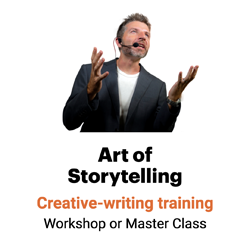3 ways to craft clever figures of speech
When a Hollywood pitchman wants to sell a new horror film about a rampaging dog, he doesn’t have time to explain the storyline. Instead of “then he did this, then he did that,” he might say:

“Think ‘Jaws’ on paws.”
Similes and metaphors are a great way to help readers understand your message. Make sure you’re moving beyond cliches — heart of stone, white as snow — and mixed metaphors to create comparisons that grab readers’ attention and help them see your ideas in a new light.
That’s just one of three ways to develop metaphors that work:
1. Anchor and twist.
Call it “anchor and twist.” To say more with less, anchor your idea to something your audience understands, then twist it to show how your concept is different from the original.
1. Anchor. “Anchoring is easier than explaining from scratch,” write Chip Heath and Dan Heath, authors of Made to Stick.
“Wikipedia says an alpaca is ‘a domesticated species of the South American camelid.’ That’s the explanation. Or, you could say an alpaca is like a small llama. Which one is easier to understand?”
In this case, “Jaws” is the anchor.
2. Twist. Highlight the differences as well as the similarities. In this case, “on paws” is the twist.
3. Try it. Here’s a fill-in-the-blanks template for an anchor-and-twist metaphor:
Think of _______ [your topic]
as ________ [anchor]
for/but/with/on ___________ [twist].
You might even get an extended metaphor from this approach.
Use this formula for a lead or sound bite in your next piece.
2. Play the metaphor game.
In A Writer’s Coach, Jack Hart shares this story:
“In A Moveable Feast, Hemingway recalls the days when he and Fitzgerald careered through the Spanish countryside in an open car, playing the metaphor game.
“One would point to an object as it came into view. The other would generate a figure of speech involving it. If he succeeded immediately, the other took his turn. If he failed, he took a drink from a jug of wine and tried again.”
Practice makes perfect. How could you play at making metaphors to polish your skills at writing analogy?
3. Practice the Popcorn Project.
In my Master the Art of Storytelling workshops, we practice observational research with the Popcorn Project.
Get some popcorn. (Go ahead. I’ll wait.) Then ask yourself:
“What’s it like?”
Try it! You’ll find that your writing becomes more rich and interesting when you go beyond listing adjectives — white and yellow, dry, bumpy — and start using your senses to compare.
Here are some of my favorite descriptions by workshop attendees:
The raucous crowd of popcorn has the filmy finish of a satin dress that’s been thrown across the room and landed in a soft lump on the carpet.
It’s the taste of Saturday-night movies, huddled with friends, our chatter filling the night air. It’s like an old friend, reminding me of youth, first kisses and whispers in the night.
This popcorn tastes like it was popped last month and shipped across the country in a slow-moving vehicle that stopped at each rest stop the driver passed.
How an you create vivid metaphors and similes that make your messages for compelling and comprehensible?
___
Sources: Anna Muoio, “Meet Hollywood’s Mr. Pitch,” Fast Company, November 1999
Chip Heath and Dan Heath, Made to Stick, Random House, 2007
Chip Heath and Dan Heath, “Selling Your Innovation: Anchor and Twist,” Fast Company, July 1, 2008

Leave a Reply